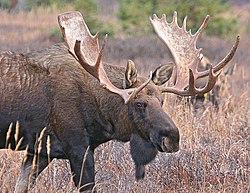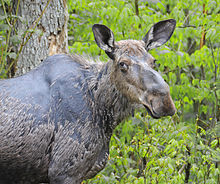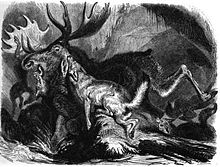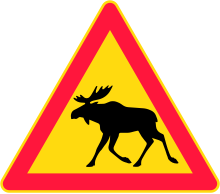| Revision as of 06:29, 28 June 2009 view sourceAlansohn (talk | contribs)Autopatrolled, Extended confirmed users, Pending changes reviewers, Rollbackers504,903 editsm Reverted edits by Mrstone56 to last revision by ClueBot (HG)← Previous edit | Revision as of 12:00, 28 June 2009 view source Vanished User 4517 (talk | contribs)11,419 editsm rv further back to last edit by WeetoddidNext edit → | ||
| Line 79: | Line 79: | ||
| | Shiras moose | | Shiras moose | ||
| | ''A. a. shirasi'' | | ''A. a. shirasi'' | ||
| | ], ], ]. Smallest species in genus. | | ], ], ]. Smallest species in genus. | ||
| |} | |} | ||
| Line 108: | Line 108: | ||
| ==Natural predators== | ==Natural predators== | ||
| ] ] from ], depicting |
] ] from ], depicting a moose being hunted by a ]]] | ||
| ] pack, as illustrated in ''The Natural History of Quadrupeds'' by Frederick Shoberl, 1834]] | ] pack, as illustrated in ''The Natural History of Quadrupeds'' by Frederick Shoberl, 1834]] | ||
| A full-grown moose has few enemies, but a pack of ] can still pose a threat, especially to females with calves.<ref></ref> ]s <ref>http://www.tigrisfoundation.nl/cms/publish/content/showpage.asp?pageid=25}</ref> and ]<ref></ref><ref></ref> are also known to prey on moose, although bears are more likely to take over a wolf kill than to hunt moose on their own.<ref></ref> ]s and ]s can be significant predators of moose calves in May and June.<ref>http://www.bearbiology.com/fileadmin/tpl/Downloads/URSUS/Vol_5/Schwartz_Franzmann_Vol_5.pdf</ref><ref>http://www.hww.ca/hww2.asp?id=87</ref> | A full-grown moose has few enemies, but a pack of ] can still pose a threat, especially to females with calves.<ref></ref> ]s <ref>http://www.tigrisfoundation.nl/cms/publish/content/showpage.asp?pageid=25}</ref> and ]<ref></ref><ref></ref> are also known to prey on moose, although bears are more likely to take over a wolf kill than to hunt moose on their own.<ref></ref> ]s and ]s can be significant predators of moose calves in May and June.<ref>http://www.bearbiology.com/fileadmin/tpl/Downloads/URSUS/Vol_5/Schwartz_Franzmann_Vol_5.pdf</ref><ref>http://www.hww.ca/hww2.asp?id=87</ref> | ||
Revision as of 12:00, 28 June 2009
"Alces" redirects here. For other uses, see Alces (disambiguation).
| Moose | |
|---|---|

| |
| Male (Bull) | |

| |
| Female (Cow) | |
| Conservation status | |
 Least Concern (IUCN 3.1) | |
| Scientific classification | |
| Kingdom: | Animalia |
| Phylum: | Chordata |
| Class: | Mammalia |
| Order: | Artiodactyla |
| Family: | Cervidae |
| Subfamily: | Capreolinae |
| Genus: | Error: {{Lang}}: text has italic markup (help) Gray, 1821 |
| Species: | Error: {{Lang}}: text has italic markup (help) |
| Binomial name | |
| Error: {{Lang}}: text has italic markup (help) (Linnaeus, 1758) | |

| |
| Moose range map | |
The moose (North America) or elk (Europe), Error: {{Lang}}: text has italic markup (help), is the largest extant species in the deer family. Moose are distinguished by the palmate antlers of the males; other members of the family have antlers with a "twig-like" configuration.
Naming and etymology
The animal bearing the scientific name Error: {{Lang}}: text has italic markup (help) is known in Europe as elk and in North America as moose. The name elk is connected with several earlier European variants—Template:Lang-la, Template:Lang-non, Scandinavian: elg, and Template:Lang-de—all of which refer to this animal.
Confusingly, the word elk in North America refers to the second largest deer species, Error: {{Lang}}: text has italic markup (help), also known as the wapiti. Early European explorers in North America, who were familiar with the closely related but smaller red deer of Central and Western Europe, believed that the much larger North American animal looked more like the European elk (i.e. moose), so they named it elk.
The word moose is derived from the Algonquian Eastern Abnaki name Error: {{Lang}}: text has italic markup (help), which loosely translates to "twig eater".
Habitat and range
Moose typically inhabit boreal and mixed deciduous forests of the Northern Hemisphere in temperate to subarctic climates.
In North America, the moose range includes almost all of Canada, most of central and western Alaska, much of New England and upstate New York, the upper Rocky Mountains, Northeastern Minnesota, and Michigan's Upper Peninsula and Isle Royale in Lake Superior. Isolated moose populations have been verified as far south as the mountains of Utah and Colorado. In 1978 a few breeding pairs were introduced in western Colorado, and the state's moose population is now more than 1,000.
In Europe, moose are found in large numbers throughout Norway, Sweden, Estonia, Finland and the Baltic States. They are also widespread through Russia. Small populations remain in Poland (Biebrza Nat. Park) and Belarus.
Moose were successfully introduced on Newfoundland in 1904 where they are now the dominant ungulate, and somewhat less successfully on Anticosti Island in the Gulf of St. Lawrence. Ten moose were also introduced in Fiordland, New Zealand in 1910, but they were thought to have died off. Nevertheless, there have been reported sightings that were thought to be false until moose hair samples were found by a New Zealand scientist in 2002. In 2008 moose (or elk) were reintroduced in to the Scottish Highlands.
Subspecies
| Common name | Binomial | Range |
|---|---|---|
| European moose | A. a. alces | Finland, Sweden, and Norway. Extirpated from Central and Western Europe except for Poland and Belarus. (Range formerly included France, Germany, and Benelux nations.) |
| Eastern moose | A. a. americana | Eastern Canada and Northeastern United States. |
| Western moose | A. a. anderson | Western Canada |
| Siberian moose | A. a. cameloides | Eastern Siberia, Mongolia, and Manchuria |
| Alaska moose | A. a. gigas | Alaska and Yukon Largest species in genus. |
| Shiras moose | A. a. shirasi | Wyoming, Utah, Colorado. Smallest species in genus. |
Description
Antlers

The male's antlers grow as cylindrical beams projecting on each side of the head at right angles to the midline of the skull, and then fork. The lower prong of this fork may be either simple, or divided into two or three tines, with some flattening.
In the North Siberian elk ( Error: {{Lang}}: text has italic markup (help)), the posterior division of the main fork divides into three tines, with no distinct flattening. In the common elk (A. a. alces) this branch usually expands into a broad palmation, with one large tine at the base, and a number of smaller snags on the free border. There is, however, a Scandinavian breed of the common elk in which the antlers are simpler, and recall those of the East Siberian animals.
The palmation appears to be more marked in North American moose ( Error: {{Lang}}: text has italic markup (help)) than in the typical Scandinavian elk.

The male will drop its antlers after the mating season and conserve energy for the winter. A new set of antlers will then regrow in the spring. Antlers take three to five months to fully develop, making them one of the fastest growing animal organs. They initially have a layer of skin called felt which is shed once the antlers become fully grown. Immature bulls may not shed their antlers for the winter, but retain them until the following spring.
If a bull moose is castrated, either by accidental or chemical means, he will quickly shed his current set of antlers and then immediately begin to grow a new set of misshapen and deformed antlers that he will wear the rest of his life without ever shedding again. The distinctive looking appendages (often referred to as "devil's antlers") are the source of several myths and legends among many groups of Inuit as well as several other tribes of indigenous peoples of North America.
Size and weight

On average, an adult moose stands 1.8–2.1 m (6–7 ft) high at the shoulder. Males weigh 380–720 kg (850–1580 pounds) and females weigh 270–360 kg (600–800 pounds). The largest of all is the Alaskan subspecies (A. a. gigas), which can stand over 2.1 m (7 ft) at the shoulder, has a span across the antlers of 1.8 m (6 ft) and averages 634.5 kg (1,396 lbs) in males and 478 kg (1,052 lbs) in females. Typically, however, the antlers of a mature specimen are between 1.2 m (3.9 ft) and 1.5 m (4.9 ft). The largest confirmed size for this species was a bull shot at the Yukon River in September 1897 weighing 820 kg (1,800 lb) and was 233 cm (92 in) tall at the shoulder. The Moose of Alaska matches the extinct Irish Elk as the largest deer of all time. Behind only the bisons, the Moose is the second largest land animal in both North America and Europe.
Social structure and reproduction
| This section needs expansion. You can help by making an edit requestadding to it . (May 2008) |

Moose are mostly diurnal. They are generally solitary with the strongest bonds between mother and calf. Two individuals can sometimes be found feeding along the same stream. The males are polygamous and will seek several females to breed with.
Mating occurs in September and October. During this times both sexes will call to each other. Males produce heavy grunting sounds that can be heard from up to 500 meters away while females produce a wail-like sound. Males will fight for access to females. They will either assess which is larger, and the smaller bull will retreat, or they may engage in battles, usually only involving the antlers. Female moose have an eight month gestation period. Most litters consist of a single calf; however, twins are not uncommon and triplets are known to occur. Newborn moose have fur with a reddish hue in contrast to the brown appearance of an adult. The young will stay with the mother until just before the next young are born.
Natural predators


A full-grown moose has few enemies, but a pack of wolves can still pose a threat, especially to females with calves. Siberian Tigers and Brown Bear are also known to prey on moose, although bears are more likely to take over a wolf kill than to hunt moose on their own. American Black Bears and Cougars can be significant predators of moose calves in May and June.
In some areas, moose are the primary source of food for wolves. Moose usually flee upon detecting wolves. Wolves usually follow moose at a distance of 100–400 meters, occasionally at a distance of 2–3 km. Attacks from wolves against young moose may last seconds, though sometimes it can be drawn out for days with adults. Sometimes, wolves will chase moose into shallow streams or onto frozen rivers, where their mobility is greatly impeded. Moose will sometimes stand their ground and defend themselves by charging at the wolves or lashing out at them with their powerful hooves. Wolves typically kill moose by tearing at their haunches and perineum, causing massive blood loss. Occasionally, a wolf may immobilise a moose by biting its sensitive nose, the pain of which can paralyze a moose. Wolf packs primarily target calves and elderly animals, but can and will take healthy, adult moose. Moose between the ages of two and eight are rarely killed by wolves. Though moose are usually hunted by packs, there are cases in which single wolves have successfully killed moose.
Moose as food
Moose are hunted as a game species in many of the countries where they are found. Moose meat tastes, wrote Henry David Thoreau in “The Maine Woods”, “like tender beef, with perhaps more flavour; sometimes like veal”. While the flesh has similar protein levels to other comparable red meats (e.g. beef, deer and elk) it has a low fat content and the fat that is found is made up of a higher proportion of polyunsaturated fats (rather than saturated fats).
Cadmium levels are high in Finnish elk liver and kidneys, with the result that consumption of these organs from elk more than one year old is prohibited in Finland. Cadmium intake has been found to be elevated amongst all consumers of elk meat, though the elk meat was found to contribute only slightly to the daily cadmium intake. However the consumption of moose liver or kidneys significantly increased cadmium intake, with the study revealing that heavy consumers of moose organs have a relatively narrow safety margin below the levels which would probably cause adverse health effects.
History

European rock drawings and cave paintings reveal that moose have been hunted since the Stone Age. Excavations in Alby, Sweden adjacent to the Stora Alvaret have yielded elk antlers in wooden hut remains from 6,000 BC, indicating some of the earliest elk hunting in northern Europe. In northern Scandinavia one can still find remains of trapping pits used for hunting elk. These pits, which can be up to 4 × 7 m wide and 2 m deep, would have been camouflaged with branches and leaves. They would have had steep sides lined with planks, making it impossible for the elk to escape once it fell in. The pits are normally found in large groups, crossing the elk's regular paths and stretching over several kilometres. Remains of wooden fences designed to guide the animals toward the pits have been found in bogs and peat. In Norway, an early example of these trapping devices has been dated to around 3,700 BC. Trapping elk in pits is an extremely effective hunting method, and as early as the 16th century the Norwegian government tried to restrict their use. Nevertheless, the method was in use until the 19th century.
The first written description of the elk is in Julius Cæsar's Commentarii de Bello Gallico, where it is described thus:
- "There are also animals which are called alces. The shape of these, and the varied colour of their skins, is much like roes, but in size they surpass them a little and are without horns, and have legs without joints and ligatures; nor do they lie down for the purpose of rest, nor, if they have been thrown down by any accident, can they raise or lift themselves up. Trees serve as beds to them; they lean themselves against them, and thus reclining only slightly, they take their rest; when the huntsmen have discovered from the footsteps of these animals whither they are accustomed to betake themselves, they either undermine all the trees at the roots, or cut into them so far that the upper part of the trees may appear to be left standing. When they have leant upon them, according to their habit, they knock down by their weight the unsupported trees, and fall down themselves along with them."
In chapter 16 of Pliny the Elder's Natural History from 77 AD the elk and an animal called achlis, which is presumably the same animal, are described thus:
- "...there is, also, the elk, which strongly resembles our steers, except that it is distinguished by the length of the ears and of the neck. There is also the achlis, which is produced in the land of Scandinavia; it has never been seen in this city, although we have had descriptions of it from many persons; it is not unlike the elk, but has no joints in the hind leg. Hence, it never lies down, but reclines against a tree while it sleeps; it can only be taken by previously cutting into the tree, and thus laying a trap for it, as otherwise, it would escape through its swiftness. Its upper lip is so extremely large, for which reason it is obliged to go backwards when grazing; otherwise, by moving onwards, the lip would get doubled up."
Dr. Valerius Geist, who emigrated to Canada from the Soviet Union wrote in his 1999 book Moose: Behaviour, Ecology, Conservation:
- "Those who care most passionately about moose are—paradoxically—hunters, in particular people who live in wilderness and rural communities and those who depend on moose for food. In Sweden, no fall menu is without a mouthwatering moose dish. The Swedes fence their highways to reduce moose fatalities and design moose-proof cars. Sweden is less than half as large as the Canadian province of British Columbia, but the annual take of moose in Sweden—upward of 150,000—is twice that of the total moose harvest in North America. That is how much Swedes cherish their moose."
Aggression

Moose are not usually aggressive animals towards humans, but can be provoked or frightened to behave with aggression. In terms of raw numbers, they attack more people than bears and wolves combined, but usually with only minor consequences. When harassed or startled by people or in the presence of a dog, moose may charge. Also, as with bears or any wild animal, moose who become habituated to being fed by people may act aggressively when denied food. During the fall mating season, bull moose may be aggressive toward humans due to the high hormone levels they experience during this time. Cow moose with young calves are very protective and will attack humans who come too close, especially if they come between mother and calf. Unlike other dangerous animals, moose are not territorial, and do not view humans as food, and will therefore usually not pursue a human if they simply run away. Like any wild animal, moose are unpredictable and should be given a respectful amount of space.
Vehicle collisions

A moose's body structure, with a large heavy body suspended on long spindly legs, makes these animals particularly dangerous when hit by motor vehicles. Such collisions are often fatal for both the moose and motorist. Generally, upon impact the bumper of the car will break the moose's legs. The main body of the moose will then collide with the windscreen, often with disastrous effect to both motorist and animal. In a collision of this nature, a car's airbags may not deploy or be of much use if they do. These risks led to the development of a vehicle test referred to as the "moose test" (Template:Lang-sv, Template:Lang-de).
Moose warning signs are used on roads in regions where there is a danger of collision with the animal. The triangular warning signs common in Sweden, Norway and Finland have become coveted souvenirs among the many German tourists traveling in these countries, and authorities have had to issue warnings that it is dangerous and criminal to remove these signs.

Norwegian newspaper Aftenposten estimated in January 2008 that some 13,000 moose had died in collisions with Norwegian trains since 2000. The state agency in charge of railroad infrastructure (Jernbaneverket) plans to spend 80 million Norwegian kroner to reduce collision rate in the future by fencing the railways, clearing vegetation from near the tracks, and providing alternative snow-free feeding places for the animals elsewhere.
In the Canadian province of New Brunswick, collisions with moose are frequent enough that all new highways have fences to prevent moose from accessing the road, similar to how it has long been done in Finland, Norway and Sweden. Demonstratively, Highway 7 between Fredericton and Saint John, which has one of the highest frequencies of moose collisions in the province, does not have these fences, although it is extremely well signed.
Domestication
Domestication of moose was investigated in the Soviet Union before World War II. Early experiments were inconclusive, but with the creation of a moose farm at Pechora-Ilych Nature Reserve in 1949 a small-scale moose domestication program was started, involving attempts at selective breeding of animals based on their behavioural characteristics. Since 1963, the programme has continued at Kostroma Moose Farm, which had a herd of 33 tame moose as of 2003. Although at this stage the farm is not expected to be a profit-making enterprise, it obtains some income from the sale of moose milk and from visiting tourist groups. Its main value, however, is seen in the opportunities it offers for the research in the physiology and behaviour of the moose, as well as in the insights it provides into the general principles of animal domestication.
References
- Template:IUCN2008
- "Moose". World Wide Fund for Nature. 2007-03-28. Retrieved 2008-11-24.
The moose (Alces alces), is the largest member of the deer family and the largest mammal in North America. Moose is an Algonquin term for 'twig eater'.
- Utah Division of Wildlife Resources
- Hairs move NZ moose out of realm of Nessie - 06 October 2005 - Dunedin and Otago News, Sport and Weather from NZ Herald
- Geist, Valerius (1998) Deer of the World: Their Evolution, Behaviour, and Ecology Stackpole Books,
- Moose Facts from Maine
- Moose
- http://www.adfg.state.ak.us/pubs/notebook/biggame/moose.php
- Wood, The Guinness Book of Animal Facts and Feats. Sterling Pub Co Inc (1983), ISBN 978-0851122359
- http://www.motherearthnews.com/Nature-Community/1989-03-01/Of-Moose-Megaloceros-and-Miracles.aspx
- Moose Reproduction
- Wolf: Wildlife Notebook Series - Alaska Department of Fish and Game
- http://www.tigrisfoundation.nl/cms/publish/content/showpage.asp?pageid=25}
- Estimating Grizzly Bear (Ursus Arctos horribilis) Abundance and Density in
- Moose: Wildlife Notebook Series - Alaska Department of Fish and Game
- Brown Bear: Wildlife Notebook Series - Alaska Department of Fish and Game
- http://www.bearbiology.com/fileadmin/tpl/Downloads/URSUS/Vol_5/Schwartz_Franzmann_Vol_5.pdf
- http://www.hww.ca/hww2.asp?id=87
- Graves, Will (2007). Wolves in Russia: Anxiety throughout the ages. Calgary: Detselig Enterprises. pp. pp.222. ISBN 1550593323. OCLC 80431846.
{{cite book}}:|pages=has extra text (help) - Watching Wolves On a Wild Ride By Les Line, National Wildlife Federation, December/January 2001, vol. 39 no. 1
- Alaska Science Forum, June 10, 2004 Are ravens responsible for wolf packs? Article #1702 by Ned Rozell
- http://www.nutritiondata.com/facts-C00001-01c22al.html www.nutritiondata.com
- All-clear for Finnish foods
- Vahteristo, L., Lyytikäinen, T., Venäläinen, E. R., Eskola, M., Lindfors, E., Pohjanvirta, R., & Maijala, R. (2003). Cadmium intake of moose hunters in Finland from consumption of moose meat, liver and kidney. Food Additives and Contamination, 20, 453-463.
- http://wildlife.alaska.gov/index.cfm?adfg=aawildlife.agmoose
- Number 1, 2004, of Nordic Road & Transport Research. Annotations Sweden
- Railroad takes steps to reduce moose crashes Aftenposten 28 January 2008
- Moose-Vehicle Collision Information - New Brunswick Department of Transportation
Further reading
- Alces, a journal devoted to the biology and management of moose ( Error: {{Lang}}: text has italic markup (help))
External links
- "Alces alces". Integrated Taxonomic Information System. 18 March.
{{cite web}}: Check date values in:|date=and|year=/|date=mismatch (help) - A moose in the National Nature Park "Losinyj Ostrov" (Elk's Island) in Russia
| Game animals and shooting in North America | ||
|---|---|---|
| Game birds |  | |
| Waterfowl | ||
| Big game | ||
| Other quarry | ||
| See also | ||